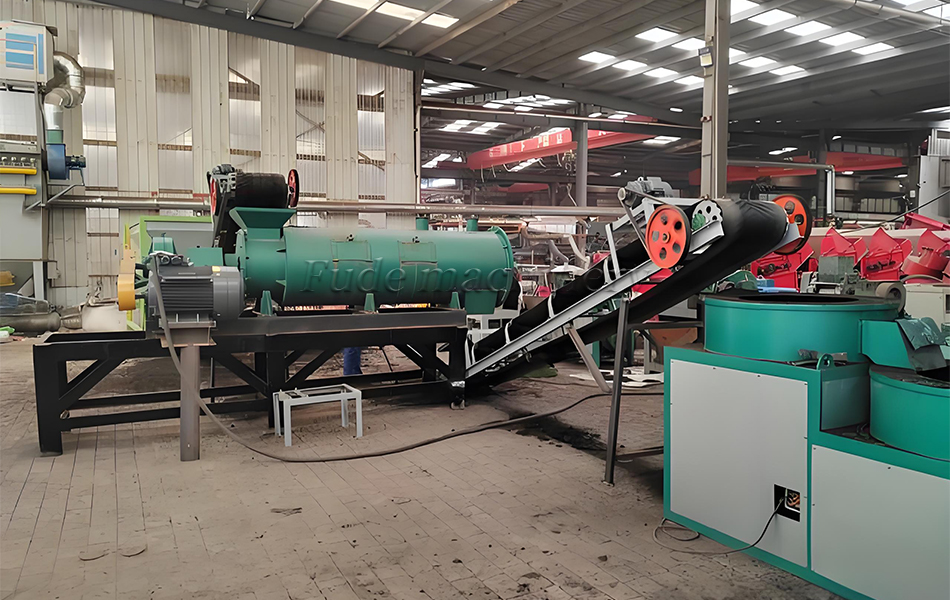What machine is used to make organic fertilizer
301It is an important equipment for making organic fertilizers
View detailsSearch the whole station
Inconsistent fertilizer means unpredictable plant nutrition. This variability can stress plants and limit their growth. Proper equipment ensures consistent processing for reliable nutrient delivery.
Our equipment controls composting maturity, particle size through crushing and granulation, and blend uniformity via mixing. These factors directly govern how quickly and effectively nutrients become available for plant uptake.
The way organic materials are processed heavily influences the final fertilizer’s effectiveness. Different machines in the production line play specific roles in determining nutrient availability. As Zhengzhou Fude Machinery, we understand how each step contributes.

Proper composting is crucial. Our compost turners (like groove type, crawler type, wheel type) ensure thorough aeration and temperature control. This stabilization process breaks down complex organic matter. It converts nutrients into forms more readily available to plants. Immature compost can harm plants or release nutrients too slowly. Mature compost provides a steady nutrient supply.
Particle size matters for nutrient release. Our crushing equipment (vertical, horizontal, wet material crushers) breaks down large clumps after composting. This increases the surface area. Smaller particles decompose faster and release nutrients more quickly. Screening machines then separate particles by size. This allows for products with different release rates, tailored to specific crop needs. Uniform particle size also ensures even distribution in the field.
Uniform mixing is essential. Our mixing machines ensure all ingredients, including nutrient supplements, are evenly distributed. This prevents nutrient hot spots or deficiencies. Granulation equipment (like disc, roller, or new type granulators) then forms uniform pellets. Granulation affects density and breakdown speed. This influences how quickly water penetrates the granule and releases nutrients into the soil. Controlled granulation leads to predictable nutrient release patterns.
Producing standard organic fertilizer is one thing. Meeting the growing demand for high-efficiency, specialized products is another. Generic fertilizers may not satisfy specific crop requirements or market expectations.
The market increasingly seeks organic fertilizers that perform consistently and offer specific benefits. Advanced technologies in fermentation and granulation are key to producing these premium products. We utilize these technologies to help our clients succeed.

Granulation transforms processed organic matter into user-friendly pellets. Advanced granulation technologies offered by Fude Machinery provide greater control over pellet characteristics.
Our specialized equipment processes diverse organic wastes like manure, crop residues, sludge, and food scraps into safe, nutrient-rich organic fertilizer. This conversion recycles vital nutrients, reduces pollution, and provides essential organic matter for healthier soil and plants.
Turning waste into valuable fertilizer is a core function of organic fertilizer production. It addresses environmental concerns while creating a product that boosts agricultural productivity. Our machinery is designed to handle a wide range of organic waste streams effectively.
| Waste Type | Key Challenge | Relevant Fude Machinery Equipment | Benefit of Processing |
|---|---|---|---|
| Livestock Manure | High moisture, pathogens | Compost Turners, Mixers | Safe, stable nutrient source |
| Crop Residues | Bulky, slow decomposition | Crushers, Compost Turners | Improved soil structure, nutrients |
| Municipal Sludge | Potential contaminants | Controlled Composting Systems | Safe disposal, nutrient recovery |
| Food/Agro-Waste | Variable composition | Mixers, Crushers, Granulators | Resource recovery, soil amendment |
A complete production line integrates all necessary steps: composting, crushing, mixing, granulating, drying, screening, and packaging. This ensures controlled processing, consistent quality, balanced nutrients, and optimal physical form for maximum plant absorption and growth.

Achieving the best results for plant growth requires a fertilizer product that is consistent, balanced, and easy for plants to utilize. A complete, well-designed organic fertilizer production line, like those we provide at Zhengzhou Fude Machinery, is engineered to achieve this outcome systematically.
A complete line ensures each step works in harmony with the next.
This integrated approach directly impacts fertilizer quality and its effect on plants.
Professional organic fertilizer equipment is vital. It transforms waste, ensures nutrient quality, meets market demands, and ultimately unlocks superior plant growth for sustainable agriculture success.
It is an important equipment for making organic fertilizers
View detailsIt converts organic waste into nutrient rich organic fertilizers.
View detailsThe organic fertilizer pellet production line has important application value in agricultural production.
View detailsThe production process of organic fertilizers is a complex and delicate process
View details